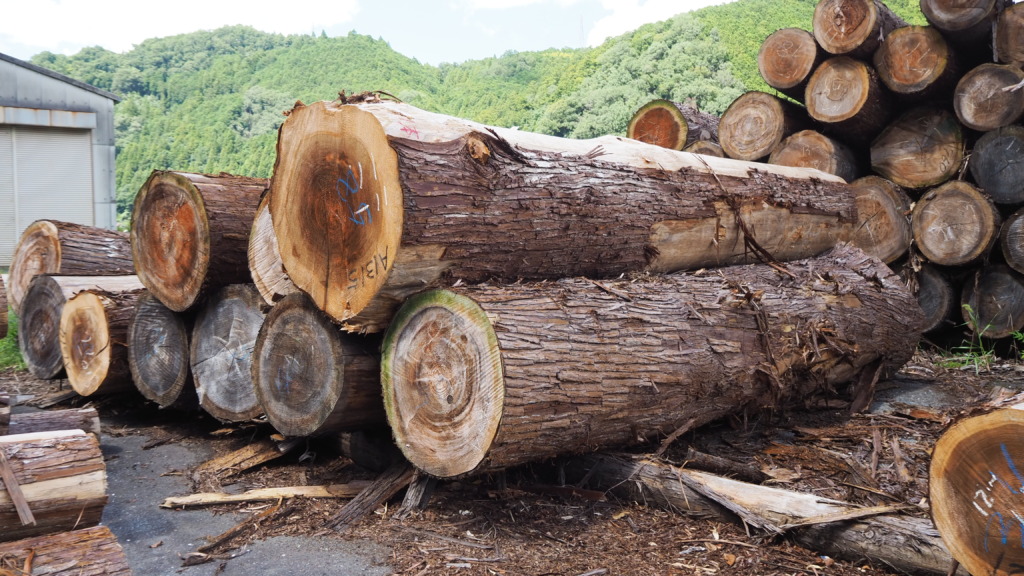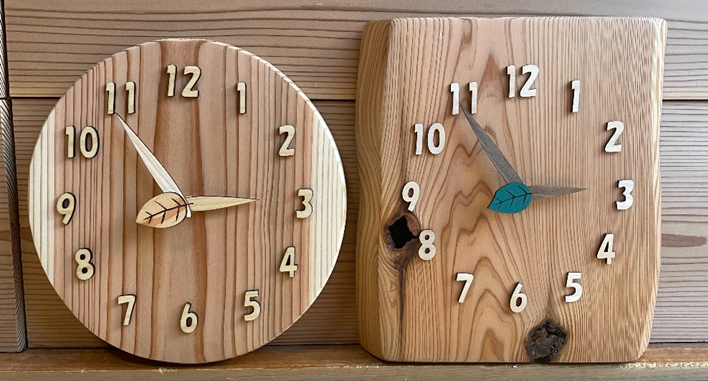About Yoshino Wood

●About Yoshino Wood
In the Yoshino region of Nara Prefecture, the premium lumber known as “Yoshino Sugi (Japanese cedar) and Yoshino Hinoki (Japanese cypress),” is commonly referred to as Yoshino Wood. These woods, grown in the Yoshino region, which is celebrated as one of Japan’s three major man-made forests, have a long history of afforestation dating back to the late Muromachi period. Notably, Yoshino Sugi was used in the construction of Osaka Castle and Fushimi Castle, both built by the renowned warlord Toyotomi Hideyoshi.
In 2016, the historical significance of these woods was recognized, and they were registered as a Japanese heritage site under the name “Yoshino: The Birthplace of Afforestation, Nurtured by the Forest and its People’s Lives and Spirits,” as part of the Beautiful Forests Network.
The distinctive features of Yoshino forestry include extremely dense planting and repeated thinning during an extended felling period, as well as the interplanting of cedar and cypress trees. While typically, 3,000 trees are planted per hectare, in the Yoshino region, 8,000 to 10,000 trees are planted per hectare. These trees are carefully nurtured over many years through repeated thinning and pruning to match their growth. Furthermore, while the typical felling period for wood is 40 to 50 years, in Yoshino, it extends to 80 to 100 years. This results in wood that has been lovingly cared for over four generations, maintaining a consistent thickness in the trunk, fine annual rings, and fewer knots. This careful cultivation process yields high-quality lumber that is highly regarded and used for various purposes.

●Features of Cedar and Hinoki
Cedar and Hinoki are evergreen conifers native to Japan and have been used in many homes for centuries.
Cedar: Cedar, a coniferous wood, is the most commonly used wood for various purposes. Its distinct feature is the clear demarcation between the outer sapwood, which is white, and the inner heartwood, which ranges from pale pink to deep reddish-brown, sometimes even black. The wood grain is straight, with a slightly coarse texture and a unique fragrance. Low in resin content, it is soft, lightweight, and excellent for crafting, making it versatile for structural and decorative uses in homes. Cedar grows faster than Hinoki, offers high thermal insulation, and has moderate resistance to decay. Its affordability and rapid growth contribute to its high demand.
Hinoki: Hinoki, another evergreen conifer, boasts excellent drying properties and minimal warping. It is known for its softness and lightness while maintaining high strength and durability, making it a preferred choice for pillars and foundations. Notably, the world’s oldest wooden structure, Horyu-ji Temple, was constructed using Hinoki. With a glossy wood grain and a distinctive aroma, Hinoki is cherished for its use in Hinoki baths and bath products. It excels in sound insulation, humidity control, resistance to pests, water resistance, and durability against decay.
●Characteristics of Yoshino Wood
□Fine and Beautiful Annual Rings
Yoshino wood, nurtured with great care through dense planting and frequent thinning in the Yoshino region, boasts finer and more beautiful annual rings compared to wood from other regions. As a result, it exhibits exceptional strength and minimal distortion caused by changes in dryness and humidity.

The Clock on the Right is crafted from Yoshino Cedar.
The difference in the fineness of the annual rings is evident at a glance. The knots also have a pleasing appearance.
□Beautiful Color, Lustrous Sheen, and Pleasant Fragrance
In the heartwood, Cedar reveals a soothing, eye-catching pale pink hue with a refreshing fragrance that calms the senses. Hinoki, with its unique and rich aroma, emanates from its delicate pink-hued wood, offering a sense of relaxation to the soul.
□Consistent Thickness from Base to Top
Yoshino wood, cultivated through meticulous branch pruning, maintains a uniform thickness from the base to the top, growing straight and steady.
□Few Knots and Almost Circular
Thanks to the diligent efforts of our predecessors, who carried out regular branch pruning, our wood has few knots and is highly regarded as exceptionally high-quality lumber with nearly circular patterns.
□High Breathability and Water Resistance
Our wood combines a network of fine air passages, ensuring excellent breathability. This allows for proper humidity control indoors, creating a comfortable living environment.
□High Resistance to Mold, Antimicrobial Properties, Antiviral Properties, and Insect Resistance
According to a study conducted by Nara Prefecture’s Nara Wood Brand Division, Yoshino Wood has been proven to have significant effects on safeguarding health. It inhibits mold growth, suppresses the proliferation of Escherichia coli (E. coli), deters mite infestations, and deactivates viruses. This is attributed to the abundance of ‘phytoncides,’ aromatic compounds (essential oils), found in Yoshino Wood. It is also expected to contribute to the alleviation of allergy symptoms.
●Benefits of Cedar and Cypress
□Calming Fragrance
While each type of wood has its distinct aroma, cedar and cypress, in particular, are known for their relaxing effects. It is said that using cedar wood in your bedroom can promote a deeper and more restful sleep. Additionally, these woods are believed to have deodorizing properties.
□Gentle on the Eyes
While concrete reflects ultraviolet rays, wood is known to absorb them and reduce the strain caused by blue light, which can lead to eye fatigue. Using wood for interior walls can create a space that is easy on the eyes.
□Humidity Regulation
Wood is known for its humidity-regulating properties, as it can absorb moisture during high humidity and release it during low humidity conditions.
□Antimicrobial, Antiviral, and Insect-Repelling Effects
These effects have been scientifically demonstrated in experiments conducted in Nara Prefecture.
●Drawbacks of Cedar and Cypress
□Prone to Scratches
Wood, being relatively soft as a material, is susceptible to scratches. Especially when used for furniture or flooring, impacts can result in visible scratches or dents. Regular maintenance and surface treatments such as varnishing are necessary to mitigate these effects. Additionally, like most wood types, cedar and cypress are sensitive to direct sunlight and moisture.
However, this can be viewed positively as the wood ages and acquires character over time.
□Susceptible to Gaps
While further strengthening occurs through drying, it can also lead to the formation of gaps.
We are dedicated to the development of original products that showcase the beauty and durability of wood, primarily sourced from the Yoshino region. Yoshino wood possesses a unique grain pattern and stable texture, making it an excellent choice for furniture. It creates a warm and inviting atmosphere, offering a sense of tranquility in any space it adorns, enhancing the quality of life.
Our goal is to harness the distinct allure of Yoshino wood and provide new value to people’s lives through our products. We aim to utilize the region’s sustainable forest resources while preserving and protecting the local environment. With this commitment, we deliver one-of-a-kind items to our customers, each a testament to our dedication to quality and sustainability.
-e1712842507106.png)

